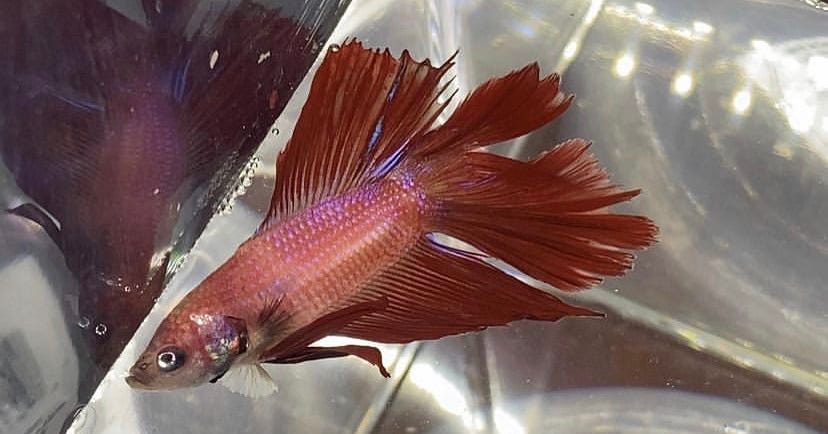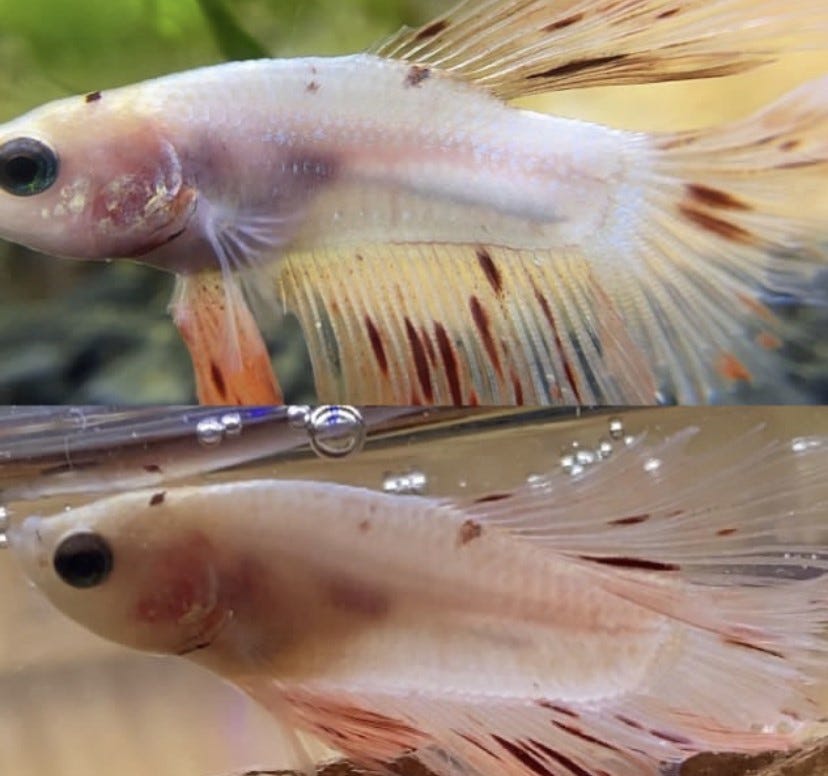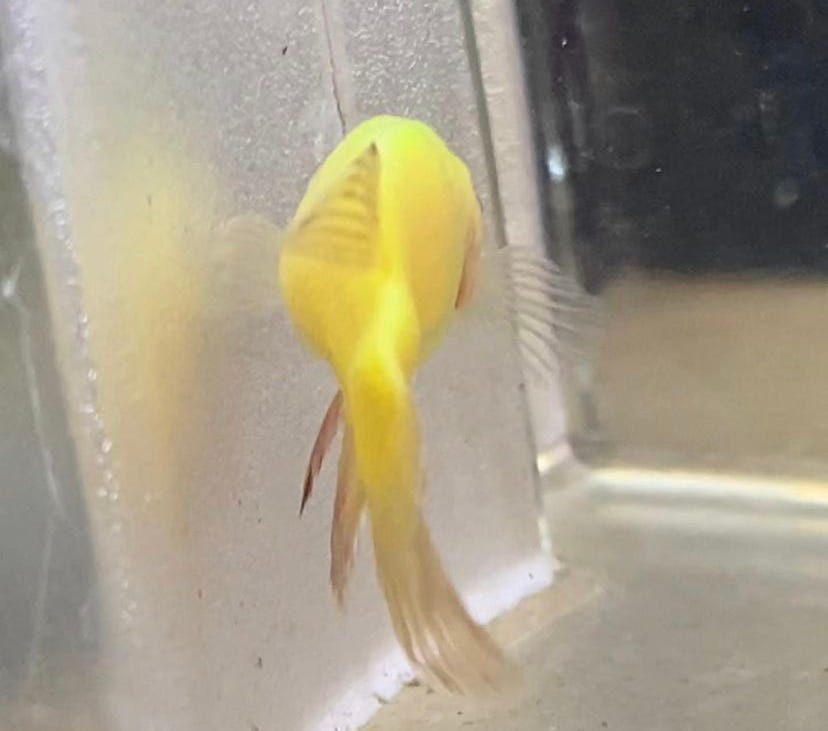Swim Bladder Disorder (SBD) is a common betta affliction that targets bettas of all ages, tail types, and sexes. SBD is characterized by bettas that cannot maintain their own natural buoyancy and either float or sink in the water column. While this broad description can be useful as an umbrella term, it is important to break SBD down into its individual types and understand the causes behind it.
So, what is SBD?
SBD is a disorder of the swim bladder itself. The swim bladder in bettas is responsible for maintaining natural, neutral buoyancy within the water column. The swim bladder is a long, skinny organ just beneath the spine that stretches from behind the gut down the full length of the body. In some lighter-colored or cellophane bettas it is visible from the outside. When something interferes with the function of the swim bladder or impairs the buoyancy of the betta in some other way, SBD develops.
Adult female betta with visible swim bladder
Types of SBD
I believe there are two different types of SBD in bettas: Floating and sinking. Each type has it’s own subtypes but this is a majorly compressed version of SBD care and treatment so I’ll be sticking to the main overview points now before getting into details later.
Floating SBD.
Floating SBD is the most common of the SBD types and in most cases is the easier one to correct. This is also the funky SBD case because most of these ills lie within the gut as the root of the issue and not with the swim bladder itself. In most cases of floating SBD, the betta is buoyant and floating due to excess air within the gut. This is extremely common in new bettas or petstore finds, and can also be caused by overeating, bloating, and ingesting plant matter. Bettas with floating SBD are unable to sink or swim correctly and can even bob at the top of the water like a cork, unable to lower themselves. Doubletail bettas are the most likely to display this type of SBD.
A floating SBD Doubletail betta. The swim bladder here is shown as a raised line down the body, which is common in Doubletails due to their body shape. It is not an indicator of the SBD itself and is natural feature.
Treatments:
Treat the gut itself. Fasting followed by rich, no-air foods such as frozen daphnia or brine shrimp can do wonders. Soaking pellets beforehand to get the air out of them can help for minor cases in bettas prone to bloat, like Crowntails. I usually start with a three-day fast before reintroducing food in small meals. Since this type of SBD does not stem from the swim bladder it tends to be an easy fix to a temporary problem. A little extra care can go a long way with these guys.
Other cases of floating bettas can be harder to solve. Some cases can be more chronic or reoccurring. And there is a condition out there that causes the swim bladder to become overinflated much like an overfull balloon, a condition that’s highly visible due to the swelling of the organ itself. While uncommon, I have seen these overinflation cases before, often in young females.
Sinking SBD
Sinking SBD is when bettas become heavier that the water around them and can no longer hover effortlessly within the water column. Some bettas sink like rocks and can only squirm around on the bottom while in others the SBD functions more as a swimming impairment.
There are different causes of this type of SBD. The first is the most common type where the swim bladder deflates or fills with fluid. In deflatment cases, the swim bladder often craps out completely and fairly quickly, leaving bettas stranded on the bottom. In the fluid cases I believe that the fluid is caused by underlying factors and will be a chronic condition.
Treatments:
Until very recently it was believed that sinking SBD was always an unfixable, often fatal solution. You still hear today that someone’s betta has died of SBD, which I do not believe to be possible in any case. SBD is not a killer. It is a manageable condition and bettas afflicted by it can still lead satisfying, fulfilled lives.
But let’s break this down by case type.
Simple sinking SBD (Deflatement or fluid):
After much thought and experimentation I have engineered a way that can reverse this process and restore function to the swim bladder. I stumbled onto this trick while thinking of sinking SBD as a pressure disorder and linking it to broken bones, so the trick is to severely limit a bettas movement and restrict them from swimming with as little water pressure over them as possible. This allows the swim bladder time to heal and rebalance itself. But stopping a betta from swimming for a month straight is no easy task. The most stress-free way I’ve found is to fill a small container with 2-3” of water and cram it full of soft, fluffy moss to lessen swimming room and provide resting places. You can feed and maintain the water as normal during this treatment. So far the success rate for this treatment style is hovering at around 75% but the pool of test subjects is small and more research needs to be done to fully verify the treatment.
James, a betta with a deflated swim bladder. The top photo shows him with a healthy swim bladder. The bottom is after his swim bladder collapsed. See the difference?
Complex Sinking SBD:
Complex sinking SBD is caused by secondary factors messing with the swim bladder, often compressing it or otherwise restricting it’s function. The most common cause of this type of SBD is a spinal deformity or other structural abnormality. This type of SBD is chronic and can worsen over time. Management is the key here.
Harriet, a betta with chronic SBD due to a crooked spine.
So how do you manage sinking SBD?
The first step is to address the tank itself. The environment a chronic SBD betta inhabits can help decide on quality of life, and the goal is to provide the highest quality of life possible. It is extremely rare to encounter a form of SBD on its own that would qualify for potential euthanasia and as a rule I do not consider SBD bettas candidates for compassionate release unless there are other factors at play. SBD alone is easy to handle, so let’s start by talking about the tank.
Smaller, shallower tanks are preferred for sinking bettas. Multiple resting places at different levels are preferred, and I’ve been playing around with a tier-system similar to rice paddies with their different levels to provide variety within the tank. Some bettas will be able to handle larger tanks and some will not. Knowing each individual betta’s needs is a must. You don’t want them in a tank that’ll tire them out just from getting around, and the water current can’t be strong enough to toss them about the place either. There’s a fine middle ground that exists where SBD bettas are able to thrive.
Having an SBD betta doesn’t have to be heartbreaking. The most severe side effects I’ve noticed are in floating bettas, who can develop sores and ulcers on body parts often left out of the water that dry out over time. And sinking SBD bettas can develop muscle wasting in the back end from disuse. Part of pet ownership includes caring for your betta even when the care goes beyond what was originally assumed at the point of purchase. Bettas can be incredibly rewarding pets when the proper care and effort is put into them. They’ll reward your love tenfold.
Yes, even the SBD ones…
(Side note: My picture quality! Where did it go? Noooooooooooooo)






